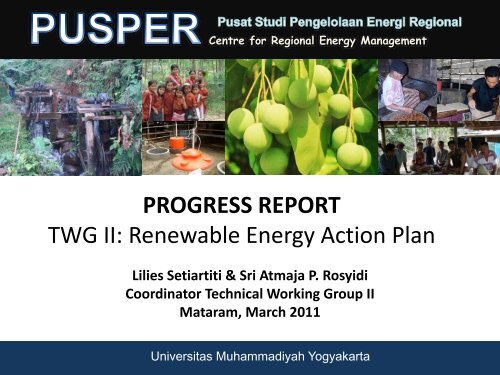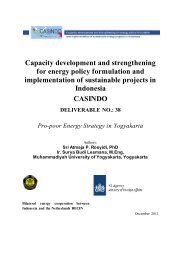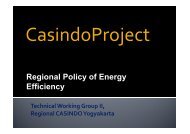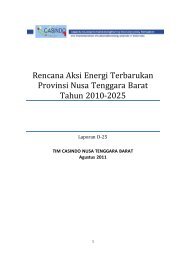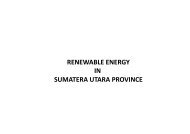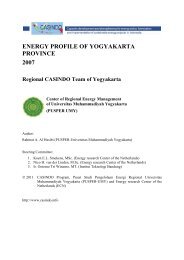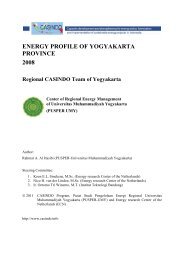PROGRESS REPORT TWG II Renewable Energy Action ... - Casindo
PROGRESS REPORT TWG II Renewable Energy Action ... - Casindo
PROGRESS REPORT TWG II Renewable Energy Action ... - Casindo
Create successful ePaper yourself
Turn your PDF publications into a flip-book with our unique Google optimized e-Paper software.
<strong>PROGRESS</strong> <strong>REPORT</strong><br />
<strong>TWG</strong> <strong>II</strong>: <strong>Renewable</strong> <strong>Energy</strong> <strong>Action</strong> Plan<br />
Lilies Setiartiti & Sri Atmaja P. Rosyidi<br />
Coordinator Technical Working Group <strong>II</strong><br />
Mataram, March 2011<br />
Universitas Muhammadiyah Yogyakarta
Chapter 1<br />
INTRODUCTION
Methodology<br />
Current<br />
Situation<br />
Analysis<br />
RE <strong>Action</strong><br />
Plan<br />
RE Dev’t<br />
Target<br />
RE potential the region<br />
RE policy in the region<br />
RE utilization in the region<br />
RE dev’t opportunities<br />
Supply‐demand analysis<br />
Implementation strategy<br />
National policy on RE dev’t<br />
Setting of RE dev’t target
National <strong>Energy</strong> Policy
Final <strong>Energy</strong> Consumption for Yogyakarta<br />
(KED, Regional <strong>Energy</strong> Policy Scenario)<br />
2007 2025<br />
<strong>Energy</strong> Elasticity:<br />
‐ Electricity : 1,18<br />
‐ Fuel : 2,03<br />
Target of <strong>Energy</strong> Elasticity:<br />
‐ Electricity:
Chapter 2<br />
DETAIL TARGET & GENERAL<br />
REGIONAL PROGRAMS
Target on <strong>Renewable</strong> <strong>Energy</strong> Development Roadmap<br />
for Yogyakarta<br />
PLTS<br />
2010 2015 2020 2025<br />
25 KWp 250 KWp 2000 KWp 3000 KWp
Program/Policy of PLTS in Municipality<br />
• To reduce the electricity use from PLN grid particularly in peak<br />
hours.<br />
• To increase the use of clean and environmental friendly<br />
renewable energy in municipality<br />
No. Customer category Total Percentage (%)<br />
1. Social 19,684 2.44<br />
Household 757,725 92.70<br />
R1-450 VA 465,568 58.78<br />
R1-900 VA 205,534 29.31<br />
2. R1-1300 VA 53,241 7.59<br />
R1-2200 VA 23,170 3.31<br />
R2-3.500 - 5.500 VA 6373 0.91<br />
R3-6.600 VA and above 626 0.08<br />
3. Commercial use 30,562 3.79<br />
4. Industry 476 0.06<br />
5. Public 5564 0.69<br />
6. Others 2613 0.31<br />
Total 805,468 100<br />
Source: PT PLN (Persero) APJ Yogyakarta, April 2010
PLTS System in Municipality :<br />
Hybrid System with PLN Grid
PLTS in Municipality: The use for PLN Costumer R2 and R3<br />
‐ Costumer3500 VA<br />
‐ PLTS<br />
10% x 3500 VA = 350 VA<br />
Total: 2 unit x 175 Wp<br />
Note:<br />
1. Fuel cell unit installed in proper location in<br />
house for optimal electrical generator.<br />
2. Inverter (controller) changes electricity in DC<br />
(from PV) to AC, therefore, it can be used for<br />
electrical equipments.<br />
3. Distribution box is used to distribute AC<br />
electricity from PV to electricity grid from<br />
PLN.<br />
4. Use of AC system.<br />
5. Electrical meter to measure the electricity use<br />
from PLN.
PLTS in Rural<br />
General Program/Policy<br />
• To increase the energy access in isolated/rural<br />
community<br />
• To provide the job opportunity<br />
• To increase level of life in rural community
Road Map Pengembangan Energi Terbarukan<br />
Provinsi DIY<br />
PLTMH<br />
2010 2015 2020 2025<br />
8 unit<br />
terpasang<br />
15 unit<br />
terpasang<br />
20 unit<br />
terpasang<br />
25 unit<br />
terpasang<br />
25 Kw 50 Kw 600 Kw 750 Kw
General Program/Policy for<br />
PLTMH<br />
• To optimize the potential of irrigation channel for MHPP development<br />
• To develop “pikrohidro” for small scale (rural household)<br />
• To promote the MHPP development for economic production activities,<br />
increasing the community income and increasing the number of wjob<br />
opportunity<br />
• To develop the MHPP workshop for operation and maintenance purpose.
Target on <strong>Renewable</strong> <strong>Energy</strong> Development Roadmap<br />
for Yogyakarta<br />
PLT Angin<br />
2010 2015 2020 2025<br />
20 Kw 40 Kw 80 Kw 160 Kw
General Program/Policy of PLT Angin<br />
Development<br />
• To develop wind turbine technology for power plant in scale of 500 VA<br />
– 2500 VA by wind farm configuration<br />
• To develop the wind turbine for electricity generator, which can be<br />
used for economic production activities and water supply in irrigation<br />
system or water resources for coastal area in southern part of<br />
Yogyakarta<br />
• To develop the workshops of PLT Angin for operation and<br />
maintenance purposes
Target on <strong>Renewable</strong> <strong>Energy</strong> Development Roadmap for<br />
Yogyakarta<br />
Biogas<br />
2010 2015 2020 2025<br />
300<br />
installed unit<br />
1,000<br />
installed unit<br />
2,500<br />
installed unit<br />
5,000<br />
installed unit
General Program/Policy for Biogas<br />
• To do biogas potential identification in Yogyakarta in which<br />
feasible developed.<br />
• To optimize the use of animal dugs in rural community.<br />
• To promote the liquid energy from biogas by using the<br />
appropriate technology.<br />
• To promote the private partnership in biogas development<br />
For lighting<br />
For alternative energy<br />
sources
<strong>Renewable</strong> <strong>Energy</strong> Development<br />
Opportunities<br />
Type of <strong>Energy</strong> Local Tradable<br />
Hydro -<br />
Mini/Micro hydro 1,490 kW 1,490 kW<br />
Geothermal -<br />
Biodiesel - -<br />
Bioethanol - -<br />
Biomass 143.25 MWh 38.54 MWh<br />
Biogas 37,377 sbm/year 37,377 sbm/year<br />
Wind 2,390 kW 2,390 kW<br />
Solar 10 kW/year 10 kW/year<br />
Other - -
SUPPLY AND DEMAND ANALYSIS
Introduction<br />
• <strong>Renewable</strong> <strong>Energy</strong> categorized in two:<br />
• Local energy<br />
• Tradable energy<br />
The categorize change within a certain condition,<br />
before : no available grid connection<br />
after : grid connection available
Utilization of renewable energy :<br />
• only available energy in region, i.e. solar home<br />
system in remote area<br />
• Substitute fossil fuel , i.e. using biogas to<br />
replace diesel oil for genset<br />
• Utilize waste, for biomass and biogas<br />
• Business, i.e. grid connecting microhydro,<br />
biomass power plant, jatropha plantation
Microhydro<br />
No Kab/Kota Location<br />
Potency Micro hydro (KW)<br />
Local<br />
Tradable<br />
1Kulonprogo 946.7 880<br />
2Sleman 537.7 395<br />
3Yogyakarta 12.4 ‐<br />
4Bantul 185 180<br />
5Gunungkidul 56.6 35<br />
Total 1738.4 1490
Biomass<br />
No.<br />
Regency/City<br />
Biomas Potential (ton)<br />
Wet (ton) Dry (ton) MWH SBM<br />
1 Kulonprogo 230,307.31 115,153.66 115,153.66 72,661.96<br />
2 Bantul 312,829.73 156,414.87 156,414.87 98,697.78<br />
3 Gunungkidul 976,933.46 488,466.73 488,466.73 308,222.51<br />
4 Sleman 485,764.97 242,882.48 242,882.48 153,258.85<br />
5 Yogyakarta 1,912.67 956.34 956.34 603.45<br />
Total 2,007,748.14 1,003,874.07 1,003,874.07 633,444.54
Calculation local potency<br />
green (wet) ton of biomass 2,007,748.14<br />
dry ton (assume with 50% moisture) 1,003,874.07<br />
1 dry ton of biomass burned in typical commercial burner will produce 10,000 lbs<br />
of steam<br />
10,000 lbs of steam will produce about 1,000 hours power or generate 1 MWH of<br />
electricity<br />
assume:<br />
plant efficiency 30%<br />
operation hours 7008 hours/year (capacity factor of 80%)<br />
equivalent capacity 143.25 MWh
tradable<br />
tradable<br />
green (wet) 540221.357<br />
dry (50 %) 270110.6785<br />
assume:<br />
plant efficiency 0.3<br />
operation hours 7008hours/year<br />
(capacity factor of<br />
80%)<br />
equivalent<br />
capacity 38.54319043MWh ‐‐‐> 270110.6785 165577.8459 SBM
Biogas Potency<br />
Cows<br />
No Kab/Kota<br />
Total % Sapi Biogas<br />
Manure (kg) Gas (m3) /kg Kerosene (L) Kliter SBM/hari SBM/tahun<br />
19.6147339<br />
1 Kulonprogo 44478 20 177912 5337.36 3309.1632 3.3091632 5 5727.502314<br />
21.2371676<br />
2 Bantul 48157 20 192628 5778.84 3582.8808 3.5828808 5 6201.252955<br />
72.2269646<br />
3 Gunungkidul 109187 30 655122 19653.66 12185.2692 12.1852692 6 21090.27368<br />
14.8860166<br />
4 Sleman 45007 15 135021 4050.63 2511.3906 2.5113906 4 4346.71686<br />
5 Yogyakarta 181 10 362 10.86 6.7332 0.0067332 0.03991037 11.65382795<br />
Total 247010 37377.39964<br />
Note: % Sapi Biogas = percentage number of cows that can<br />
be use for biogas
Wind<br />
No Kab/Kota Location<br />
Potensi PLT Angin (MW)<br />
Local Tradable<br />
1 Kulonprogo Jangkaran 0.2 0.17<br />
Glagah 0.2 0.17<br />
Karangwuni 0.3 0.2<br />
Garongan 0.2 0.17<br />
Pleret 0.2 0.17<br />
Banaran 0.2 0.17<br />
2 Bantul Kretek<br />
Sanden<br />
Srandakan<br />
0.6 0.5<br />
3 Gunungkidul Girisubo 0.2 0.17<br />
Purwosari 0.2 0.17<br />
Saptosari<br />
Tanjungsari<br />
Tepus<br />
0.6 0.5<br />
Total 2.9 2.39
Solar energy<br />
• potency based on capability of region to<br />
provide/build<br />
No Kab/Kota Lokasi<br />
Potensi PLTS (unit)<br />
Local<br />
Tradable<br />
1 Kulonprogo 3 desa 200 75<br />
2 Bantul Bantul 100 50<br />
3 Gunungkidul 11 desa 200 75<br />
Total 500 200
• Microhydro<br />
Development Scenario<br />
• Local household demand<br />
No Kab/Kota Lokasi<br />
Jumlah<br />
KK<br />
Listrik/K<br />
K (watt)<br />
Total<br />
Daya<br />
(MW)<br />
SBM/tahun<br />
1 Kulonprogo 769 0.1885 42.1759325<br />
2 Sleman 4430 1.0556 236.185222<br />
3 Yogyakarta 176 0.0176 3.937912<br />
4 Bantul 736 0.1184 26.491408<br />
5 Gunungkidul 955 0.1183 26.4690335
Skenario Demand ‐‐> assumption 2.5 % /year<br />
Local Household Demand (SBM/year)<br />
No Lokation<br />
2010 2011 2012 2013 2014 2015 2016 2017 2018 2019 2020 2021 2022 2023 2024 2025<br />
1 Kulonprogo 42.18 43.23 44.31 45.42 46.55 47.72 48.91 50.13 51.39 52.67 53.99 55.34 56.72 58.14 59.59 61.08<br />
2 Sleman 236.19 242.09 248.14 254.35 260.70 267.22 273.90 280.75 287.77 294.96 302.34 309.90 317.64 325.58 333.72 342.07<br />
3 Yogyakarta 3.94 4.04 4.14 4.24 4.35 4.46 4.57 4.68 4.80 4.92 5.04 5.17 5.30 5.43 5.56 5.70<br />
4 Bantul 26.49 27.15 27.83 28.53 29.24 29.97 30.72 31.49 32.28 33.08 33.91 34.76 35.63 36.52 37.43 38.37<br />
5 Gunungkidul 26.47 27.13 27.81 28.50 29.22 29.95 30.70 31.46 32.25 33.06 33.88 34.73 35.60 36.49 37.40 38.34<br />
Total 335.26 343.64 352.23 361.04 370.06 379.32 388.80 398.52 408.48 418.69 429.16 439.89 450.89 462.16 473.71 485.56<br />
Development Plan<br />
Lokasi<br />
No<br />
Totally Installed Capacity (MW)<br />
2010 2011 2012 2013 2014 2015 2016 2017 2018 2019 2020 2021 2022 2023 2024 2025<br />
1 Kulonprogo ‐ 0.60 0.03 0.045 ‐ 0.12 0.10 ‐ ‐ ‐ ‐ ‐ ‐ ‐ ‐ ‐<br />
2 Sleman 0.0065 ‐ ‐ ‐ ‐ 0.02 0.02 0.08 0.025 0.02 0.65 0.45 0.45 0.04 0.32 0.04<br />
3 Yogyakarta ‐ ‐ ‐ ‐ ‐ ‐ ‐ ‐ ‐ ‐ ‐ ‐ ‐ ‐ ‐ ‐<br />
4 Bantul ‐ ‐ ‐ ‐ 0.18 ‐ ‐ ‐ ‐ ‐ ‐ ‐ ‐ ‐ ‐ ‐<br />
5 Gunungkidul ‐ ‐ ‐ ‐ 0.035 ‐ ‐ ‐ ‐ ‐ ‐ ‐ ‐ ‐ ‐ ‐
Biogas
And so for :<br />
• Biomass<br />
• Wind energy<br />
• Solar energy<br />
Development scenario based on realistic target<br />
that can be achieve by Local stakeholders<br />
depend on its capability to provide
Target Development<br />
Power Plant<br />
Microhydro<br />
PLTAngin<br />
PLTBiomass<br />
Solar energy<br />
Total<br />
(SBM)<br />
2010 2015 2020 2025<br />
1.20 190.61 191.51 192.81<br />
300.12 600.25 900.37<br />
73.56 102.03<br />
231.04 434<br />
8.314 10.642 13.089 15.661<br />
83.07 603.402 1035.889 1542.84
Thank you<br />
Universitas Muhammadiyah Yogyakarta


